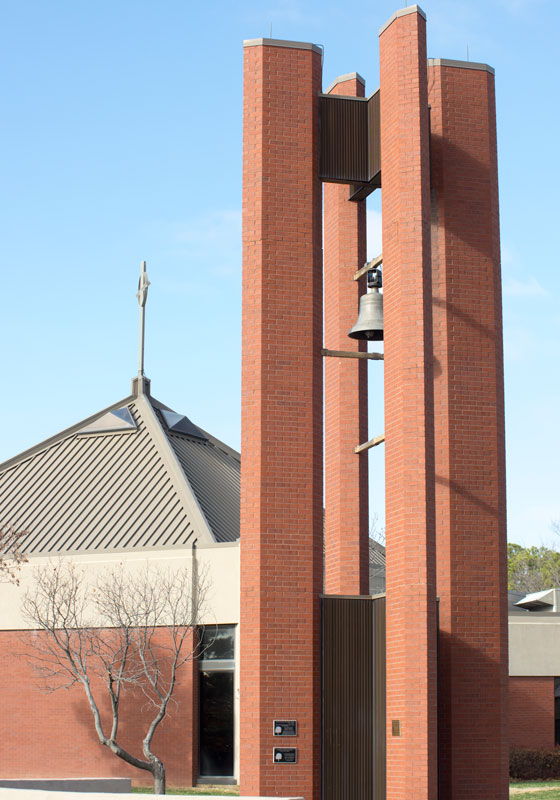Efficiency Rules
Tuesday, November 3, 2015

As president of Tulsa’s Bishop Kelley High School, the Rev. Brian O’Brien realized that the 50-plus-year-old school had pretty much its original heat and air equipment (aside from a few adjustments and repairs) — and it wouldn’t last forever.
“Between our guys and the HVAC contractor, we were about at the end of things and bandaging whatever we could,” O’Brien says.
“At a meeting one day, we realized we really only had about a year left on our current equipment,” O’Brien says. “So we started looking at how to change it.”
Looking at conventional systems led officials to the realization that finances would be the first obstacle to the upgrades.
As a private school, Bishop Kelley doesn’t get state funding; anything added to the budget generally is passed on to parents. O’Brien checked with the Diocese of Tulsa about financial assistance in this case.
Catholic Foundation of Eastern Oklahoma committee member Matt Coughlin, who has a geothermal system in his home, suggested O’Brien look into geothermal systems and get back to the committee.
Knowing that geothermal cost much more than a conventional system, O’Brien thought they would give that a quick look and come back to the original plan.
A school parent whose local manufacturing outfit uses geothermal systems offered to give him a tour, piquing O’Brien’s interest and need for more information. The school’s biggest obstacle was still the expense.
“Since it is greener, and it would save us money in the long run, we thought we had a good chance to raise the money,” O’Brien says. And he was right. Through a number of creative efforts, the school reached the fundraising goal. The environmental aspect of the geothermal was a huge factor in helping raise the needed funds, he says.
Coughlin was advocating the use of geothermal from his personal experience. He was also on the committee that would decide whether to offer financial help to the school. In the end, he influenced a decision to make a $500,000 matching grant to Bishop Kelley for the geothermal HVAC upgrade.
“They could see proven return on investment and longer lifespan on equipment, along with lower maintenance,” O’Brien says. “So they ended up giving us more.” Bishop Kelley met the match requirement for the funding.
K&M Shillingford (KMS), a Tulsa firm that claims to be the oldest geothermal heating and air conditioning company in the United States, handled the work. Tom Nowak at KMS designed the 230-ton system, working with Pete Shillingford, Jay Murphy, Ron Willis, Jeremy Garrison and Shawn Miller to get it installed.
The short timeline of two months for each phase was challenging, says Nowak, who used his top-notch problem-solving skills on the project.
“We looked at a district arrangement, but individual tonnages for the buildings was sufficient and most economical,” Jay Murphy said.
The administration offices and classrooms had the crew dealing with an existing underground structure under the main building.
“Mechanically what they have is a big central plant and then tunnels under the building,” Murphy says. “We had to figure out how to make it simple and still zone it.” The ducts ended up running down the tunnel.
“Nowak said he thought he could put a machine in the tunnel under every classroom,” Murphy says. “The guys created a trolley system to pull the units into the tunnels and came up with tools and ideas to get the project done on time.”
“Father saying a prayer over it was a really cool thing,” Murphy says. “Most outfits don’t get the experience of having a priest bless their work and equipment.”
The geothermal installation was all ClimateMaster equipment with one 8-ton, three 10-ton, two 12-ton, two 14-ton, and seven 20-ton units. Environmental Loop Service Inc., also of Tulsa, handled the ground exchange work, drilling 115 boreholes at 400 feet deep.
The geothermal system was $987,414 to install. Bishop Kelley received a credit of more than $21,000 from local power utility Public Service of Oklahoma.
The three-phase project started in the summer of 2012, drilling 66 boreholes in the school’s athletic field. All would be back to normal by game time.
Bishop Kelley spent about $70,000 on an extensive new control system for the entire campus in Phase I. Johnson Controls got that work done in time for the start of school that August. It allowed some savings by selective use of heat and air, but nothing compared with what was to come.
Phase II, the conversion to geothermal heat and air for the main building housing administration offices and 25 classrooms, took place during the summer break of 2013. In the summer of 2014, Phase III work put geothermal heat and air in the cafeteria and both gymnasiums.
“Half of our square footage is now geothermal,” O’Brien says. “We know it is working because nobody is talking about it.”
The school has seen “a definite decrease in energy bills from the quarter of a million dollars the school saw previously,” O’Brien says. Plus, there’s an educational component: Bishop Kelley students will be able to learn about the importance of renewable energy and the new geothermal system.
O’Brien says he gets questions from other principals all the time.
“Basically, they are interested in the cost savings,” he says.
